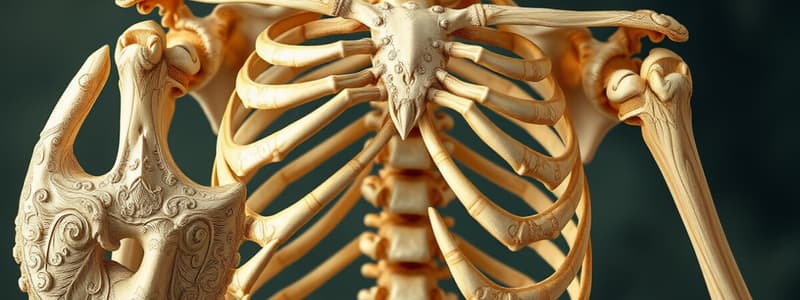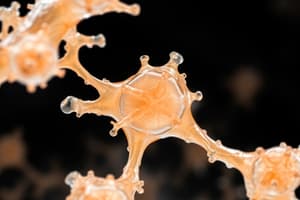Podcast
Questions and Answers
What hormone increases osteoblast activity and decreases blood calcium levels?
What hormone increases osteoblast activity and decreases blood calcium levels?
- Growth hormone
- Parathyroid Hormone
- Calcitonin (correct)
- Thyroxine
Which of the following statements about bone replacement is true?
Which of the following statements about bone replacement is true?
- Face bones are always fully replaced.
- 25% of bone is replaced every year. (correct)
- The distal femur is replaced every 6 months.
- The distal femur is never replaced.
What condition is characterized by severe loss of bone resulting in a loss of function?
What condition is characterized by severe loss of bone resulting in a loss of function?
- Osteopenia
- Osteoporosis (correct)
- Kyphosis
- Scoliosis
Which of the following represents abnormal lateral curvature of the spine?
Which of the following represents abnormal lateral curvature of the spine?
Which hormone decreases osteoclast activity in response to decreasing blood calcium levels?
Which hormone decreases osteoclast activity in response to decreasing blood calcium levels?
What bone marking feature includes elevations, projections, and depressions?
What bone marking feature includes elevations, projections, and depressions?
Which skeletal disorder is characterized by an exaggerated lumbar curve?
Which skeletal disorder is characterized by an exaggerated lumbar curve?
What role do bones primarily play in the body regarding calcium?
What role do bones primarily play in the body regarding calcium?
What is one of the primary functions of the skeletal system?
What is one of the primary functions of the skeletal system?
Which type of bone is characterized by limited stresses in a single direction?
Which type of bone is characterized by limited stresses in a single direction?
Which cells in bone are responsible for synthesizing new bone matrix?
Which cells in bone are responsible for synthesizing new bone matrix?
What does the term 'ossification' refer to in bone development?
What does the term 'ossification' refer to in bone development?
In which type of ossification does bone formation occur directly without a cartilage model?
In which type of ossification does bone formation occur directly without a cartilage model?
What is the main difference between compact bone and spongy bone?
What is the main difference between compact bone and spongy bone?
Which structure is responsible for connecting bone to bone within joints?
Which structure is responsible for connecting bone to bone within joints?
What is the functional unit of compact bone called?
What is the functional unit of compact bone called?
What remains after the replacement of hyaline cartilage in endochondral ossification?
What remains after the replacement of hyaline cartilage in endochondral ossification?
What is the primary role of osteoclasts in the skeletal system?
What is the primary role of osteoclasts in the skeletal system?
Flashcards are hidden until you start studying
Study Notes
Functions of the Skeletal System
- Provides support and structure to the body
- Facilitates movement by serving as levers for muscles
- Stores minerals (e.g., calcium) and lipids for energy
- Produces blood cells through hematopoiesis
- Protects vital organs (e.g., brain, heart)
- Offers leverage for mechanical advantage during movement
Classification of Bones
- Long bones: Examples include femur and humerus
- Short bones: Examples include carpals
- Flat bones: Examples include parietal and sternum
- Irregular bones: Examples include vertebrae and pelvis
- Sesamoid bones: Develop within a tendon, e.g., patella
- Sutural bones: Variable bones found in the skull
Bone Structure
- Comprised of compact bone (dense) and spongy bone (cancellous)
- Long bone anatomy includes:
- Diaphysis: Shaft of the bone
- Epiphyses: Ends of the bone
- Metaphysis: Region where diaphysis and epiphyses meet
- Articular cartilage: Hyaline cartilage at the ends
- Marrow cavity: Central hollow space for red or yellow marrow
- Periosteum: Protective outer membrane
Bone Histology
- Solid matrix of osseous tissue with mineral deposits in lamellae
- Cells scattered in a matrix of collagen and calcium salts
- Osteocytes: Mature bone cells located in lacunae
- Osteoblasts: Bone-forming cells responsible for osteogenesis
- Osteoclasts: Cells that dissolve bone matrix
- Osteoprogenitor cells: Stem cells that differentiate into osteoblasts
Types of Bone Development
- Endochondral ossification:
- Hyaline cartilage model transformed into bone
- Occurs at primary and secondary ossification centers
- Involves chondrocyte hypertrophy and blood vessel invasion
- Intramembranous ossification:
- Bone developed directly from connective tissue, without cartilage
- Primarily gives rise to flat bones of the skull and clavicles
Bone Remodeling
- Continuous process replacing old bone with new tissue
- 25% of bone replaced annually; notable for distal femur (every 4 months)
- Hormones like growth hormone and thyroxine enhance bone mass
- Calcitonin and parathyroid hormone (PTH) regulate calcium levels:
- Calcitonin: Decreases blood calcium by stimulating osteoblasts
- PTH: Increases blood calcium by stimulating osteoclasts
Calcium Homeostasis
- 99% of the body's calcium stored in the skeleton
- Calcium levels in blood maintained by bones, gastrointestinal tract, and kidneys
Fracture Repair Process
- Fracture hematoma: Blood clot forms at the fracture site
- External callus: Hard tissue forms around the outside
- Internal callus: Fibrous tissue forms within the bone
Bone Markings
- Characteristic features unique to each bone and individual
- Include elevations, projections, depressions, and grooves
Aging and Skeletal Disorders
- Osteopenia: Normal age-related bone loss
- Osteoporosis: Severe bone loss leading to dysfunction, influenced by genetics, diet, and exercise
- Kyphosis: Exaggerated thoracic curve
- Lordosis: Exaggerated lumbar curve
- Scoliosis: Abnormal lateral curve of the spine
- Spina bifida: Incomplete fusion of vertebrae
- Herniated disc: Nucleus pulposus protrudes, compressing nerves
- Compression fracture: Loss of height in vertebrae due to pressure
Studying That Suits You
Use AI to generate personalized quizzes and flashcards to suit your learning preferences.




